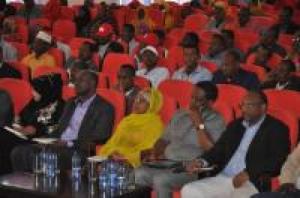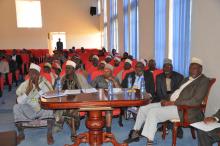Somali Region Intensifies HIV Prevention Efforts
The fourth Ethiopian HIV/AIDS Prevention Summit, held in Jigjiga, capital of the Somali Regional state of Ethiopia, 29-30 December 2014, drew attention to the concerning rise in HIV prevalence in the region. HIV prevalence has increased to 1,1% in 2014 from 0,7% in 2011. The national HIV/AIDS prevention summit called for intensified HIV response efforts in the region and the entire country.
The meeting brought together around 300 participants to share experiences, best practices and innovations to help curb the HIV/AIDS epidemic. Among those present were the State Minister of Education, the Director General of the Ethiopian Public Health Institute, the Director General of the Federal HIV/AIDS Prevention and Control Office, the First Lady of Ethiopia, high level officials from both federal and regional government, and representatives from partner agencies, including the WHO delegation led by the WHO Representative.
There are 143 health facilities in the Somali region of Ethiopia, but only 44 facilities offer prevention of mother-to-child HIV transmission (PMTCT) services. Moreover, 4,2% of pregnant women in the rural areas of the region have HIV, which is the highest figure compared to other rural areas of Ethiopia. H.E. Wzo Roman Tesfaye, the First Lady of Ethiopia and HIV/AIDS prevention advocate, emphasised at the HIV/AIDS Prevention Summit that more focus should be given to gender equality, and especially women and youth. Women are three times more affected by HIV/AIDS than men in the Somali region, which is worrying considering the rising trend of HIV prevalence.
Knowledge about the epidemic and accepting HIV/AIDS as a major public health problem was highlighted as the first step to strengthening prevention efforts. Matching and prioritizing the response, as well as tailoring plans to the regional context are crucial to intensifying prevention actions. The meeting concluded that all stakeholders should participate in the interventions. Political and religious leaders committed themselves to support the intensified HIV/AIDS prevention efforts with enhanced community dialogue to end AIDS in Ethiopia and the world.
The current HIV prevalence among adults in Ethiopia is 1,2% (UNAIDS 2013) and the country is on track to achieve the Millennium Development Goal 6 target on HIV/AIDS. Ethiopia is also one of the 13 countries that has reached the tipping point with annual number of people initiating antiretroviral therapy (ART) treatment exceeding the number of newly infected, resulting in both a 50% decrease in AIDS associated mortality and a 90% reduction in HIV incidence.
The World Health Organization is supporting Ethiopia to adopt the updated WHO guidelines on HIV/AIDS and monitor their implementation at the regional level. WHO is working with partners in the area of prevention and care to reach the MDG 6 target on HIV/AIDS and an AIDS-free generation in Ethiopia.
For more information, please contact Dr Seblewongel Abate Nigussie, HIV Team Leader, WHO Ethiopia; Email: seblewongela [at] who.int (seblewongela[at]who[dot]int).
Photos: WHO Ethiopia/ Viivi Erkkilä






